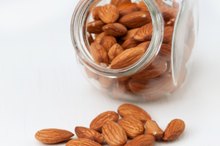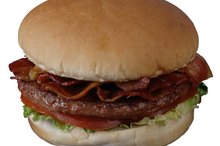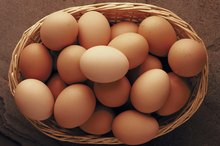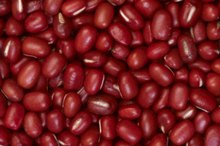What does fact checked mean?
At Healthfully, we strive to deliver objective content that is accurate and up-to-date. Our team periodically reviews articles in order to ensure content quality. The sources cited below consist of evidence from peer-reviewed journals, prominent medical organizations, academic associations, and government data.
- "Journal of Nutrition"; A Diet Rich in Conjusated Linoleic Acid and Butter Increases Lipid Peroxidation ... ; M. Raff, et al.; March 2008
- "Journal of Nutrition"; A Diet Rich in Conjusated Linoleic Acid and Butter Increases Lipid Peroxidation ... ; M. Raff, et al.; March 2008
- "Lipids in Health and Disease"; Clinical Implication of Lipid Peroxidation In Acne Vulgaris: Old Wine In New Bottles; W.P. Bowe, et al; December 2010
- "Lipids in Health and Disease"; Clinical Implication of Lipid Peroxidation In Acne Vulgaris: Old Wine In New Bottles; W.P. Bowe, et al; December 2010
- "Clinical Biochemistry"; The Relationship of Lipid Profile and Menstrual Cycle with Acne Vulgaris; M.K. Arora, et al.; December 2010
- "Clinical Biochemistry"; The Relationship of Lipid Profile and Menstrual Cycle with Acne Vulgaris; M.K. Arora, et al.; December 2010
- American Heart Association: Know Your Fats
- "Journal of the American Academy of Dermatology"; High School Dietary Intake and Teenage Acne; C.A. Adebamowo, et al; February 2005
- "Journal of the American Academy of Dermatology"; High School Dietary Intake and Teenage Acne; C.A. Adebamowo, et al; February 2005
- "Clinical Dermatology"; Nutrition and Acne; F.W. Danby; November/December 2010
- "Clinical Dermatology"; Nutrition and Acne; F.W. Danby; November/December 2010
The information contained on this site is for informational purposes only, and should not be used as a substitute for the advice of a professional health care provider. Please check with the appropriate physician regarding health questions and concerns. Although we strive to deliver accurate and up-to-date information, no guarantee to that effect is made.
Butter as a Cause of Acne
One of the most heated controversies in the field of dermatology is on the link between diet and acne. However, there does seem to be at least a modest correlation between dairy consumption and this condition, a fact that makes it reasonable to wonder whether there is a link between acne and eating butter.
Dairy Consumption and Acne
Data from the Nurses Health Study II provides evidence that dairy consumption is linked to acne, according to a 2005 article published in the "Journal of the American Academy of Dermatology." In this study, the data on more than 47,000 women who had completed questionnaires on high school diet and physician-diagnosed acne were analyzed 5. The results showed that intake of milk and milk products was correlated with acne, and that this association remained after controlling for age at menarche, body mass index and energy intake.
Lipid Peroxidation
Are Brown Rice and Sweet Potatoes Good for Acne?
Learn More
Lipid peroxidation is a process in which a free radical steals electrons away from lipids in the cell membrane, thus producing more free radicals and cell damage. According to a December 2010 article in "Lipids in Health and Disease," lipid peroxidation may be the match that "lights an inflammatory cascade in acne." This process is worsened by butter consumption, according to a 2008 article published in the "Journal of Nutrition. 2"
- Lipid peroxidation is a process in which a free radical steals electrons away from lipids in the cell membrane, thus producing more free radicals and cell damage.
- According to a December 2010 article in "Lipids in Health and Disease," lipid peroxidation may be the match that "lights an inflammatory cascade in acne."
Cholesterol Levels and Acne
According to the American Heart Association's website, dietary cholesterol, like that found in butter, can raise blood cholesterol levels 4. Cholesterol is the precursor to male hormones, which also are found in women but in lower doses. A December 2010 article in "Clinical Biochemistry" reported that both testosterone, a male hormone, and "bad" LDL cholesterol were higher in females with acne than in those without it. Correlation, however, does not prove causality.
- According to the American Heart Association's website, dietary cholesterol, like that found in butter, can raise blood cholesterol levels 4.
- A December 2010 article in "Clinical Biochemistry" reported that both testosterone, a male hormone, and "bad" LDL cholesterol were higher in females with acne than in those without it.
Milk Products Androgen Production
Vegetable Oils & Acne
Learn More
According to a 2010 article in "Clinical Dermatology," milk products in general contain 5alpha-pregnanedione and 5alpha-androstanedione, two precursors to the androgen 5alpha-hydrotestosterone. Testosterone worsens acne by promoting the production of sebum, which can block pores. According to this article, foods with high glycemic loads also also promote acne. This research suggests that If butter is eaten with carbohydrate-rich foods, like muffins and pancakes, then the resulting insulin release leads to an even higher level of androgen production and further increases the risk of developing acne.
- According to a 2010 article in "Clinical Dermatology," milk products in general contain 5alpha-pregnanedione and 5alpha-androstanedione, two precursors to the androgen 5alpha-hydrotestosterone.
- This research suggests that If butter is eaten with carbohydrate-rich foods, like muffins and pancakes, then the resulting insulin release leads to an even higher level of androgen production and further increases the risk of developing acne.
Related Articles
References
- "Journal of Nutrition"; A Diet Rich in Conjusated Linoleic Acid and Butter Increases Lipid Peroxidation ... ; M. Raff, et al.; March 2008
- "Lipids in Health and Disease"; Clinical Implication of Lipid Peroxidation In Acne Vulgaris: Old Wine In New Bottles; W.P. Bowe, et al; December 2010
- "Clinical Biochemistry"; The Relationship of Lipid Profile and Menstrual Cycle with Acne Vulgaris; M.K. Arora, et al.; December 2010
- American Heart Association: Know Your Fats
- "Journal of the American Academy of Dermatology"; High School Dietary Intake and Teenage Acne; C.A. Adebamowo, et al; February 2005
- "Clinical Dermatology"; Nutrition and Acne; F.W. Danby; November/December 2010
- American Academy of Dermatology. Acne: Who gets and causes.
- American Academy of Dermatology. Adult acne.
- Zaenglein AL, Pathy AL, Schlosser BJ, Alikhan A, Baldwin HE, Berson, DS, et al. Guidelines of care for the management of acne vulgaris. J Am Acad Dermatol. 2016;74(5):945-73.e33. doi:10.1016/j.jaad.2015.12.037
- Ju Q, Tao T, Hu T, Karadağ AS, Al-khuzaei S, Chen W. Sex hormones and acne. Clin Dermatol. 2017;35(2):130-137. doi:10.1016/j.clindermatol.2016.10.004
- Dréno B. What is new in the pathophysiology of acne, an overview. J Eur Acad Dermatol Venereol. 2017;31 Suppl 5:8-12. doi:10.1111/jdv.14374
- Juhl CR, Bergholdt HKM, Miller IM, Jemec GBE, Kanters JK, Ellervik C. Dairy intake and acne vulgaris: A systematic review and meta-analysis of 78,529 children, adolescents, and young adults. Nutrients. 2018;10(8) doi: 10.3390/nu10081049
Writer Bio
Jessica Ramer began writing professionally in 2000. She has been published in "Macrobiotics Today" and has also written "Charlie Does the SAT Math." Ramer is a Kushi Institute-certified macrobiotic instructor who holds a B.A. in mathematics and a M.A. in psychology from Florida Atlantic University.









